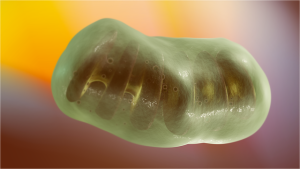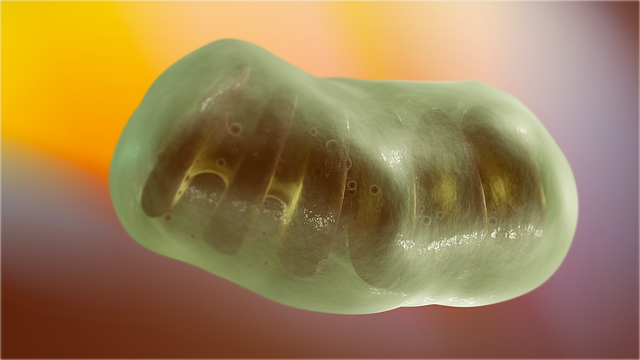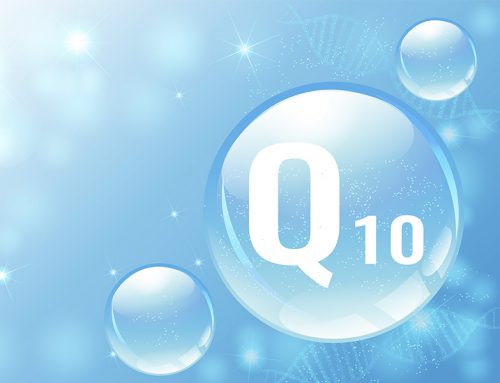Our cells contain a nucleus and many interesting organelles. Among the organelles in our cells, the mitochondria are especially interesting. Originally, far back in time, the mitochondria evolved from bacteria that lived symbiotically inside the cells. Back then, the mitochondria were an independent species. Even today, they have their own DNA, distinct from the DNA in our cells [Mayo Clinic Staff 2019].

Heart muscle cells are especially rich in mitochondria. Typically, a healthy heart muscle cell would have between 5,000 and 10,000 mitochondria. After all, the heart muscle has a great need for energy. The individual mitochondrion has a length of one to two micrometers and a diameter of 0.5 to one micrometer.
The most important thing that the mitochondria do for our cells is convert the glucose from the food we eat to ATP energy. In fact, the mitochondria are sometimes called “the powerhouses of the cells.” The mitochondria do more than this. They generate much of our body heat. They play an important role in intracellular communication and in cellular response to stress. Basically, they help cells grow and communicate, and they help cells survive [Mayo Clinic Staff 2019].
Accordingly, mitochondrial malfunction is a serious matter. Optimal mitochondrial function is necessary for good health. Mitochondrial dysfunction has an impact on aging as well as on many disorders such as cardiovascular disease and diabetes and stroke [Mayo Clinic Staff 2019].
Coenzyme Q10 and Mitochondria and Xenobiotics
In a forthcoming 2025 review article, David Mantle & Beatrice Golomb summarize the available research information about xenobiotics that induce mitochondrial dysfunction and oxidative stress. They note that xenobiotics such as environmental toxins (think: pesticides), heavy metals, industrial solvents, and endocrine disrupting agents target the mitochondria. Moreover, some pharmacological drugs and lifestyle toxicants can damage the mitochondria. Typically, exposure to these toxic substances disrupts normal mitochondrial function. This disruption results in reduced ATP production, increased free radical-induced oxidative stress, increased inflammation, and increased apoptosis [Mantle & Golomb 2025 pre-publication].
These adverse effects on mitochondrial function suggest a role for CoQ10 supplementation to offset the chemically induced mitochondrial dysfunction. Coenzyme Q10 is known to promote normal mitochondrial function and to act as an antioxidant and anti-inflammatory agent [Mantle & Hargreaves 2023].
Particularly of interest in this respect is a 2014 randomized controlled trial in which CoQ10 administration conferred significant health benefits to physical function and symptoms in veterans with Gulf War illness. These veterans had been exposed to a variety of toxic environmental chemicals that affected mitochondrial function [Golomb 2014].
Coenzyme Q10 and Mitochondria and Antibiotics
Mitochondria are sensitive to the adverse effects of many classes of antibiotics. The reason is the above-mentioned evolutionary relationship between mitochondria and bacteria. Bacteria and mitochondria share similar DNA and ribosomal structures.
Mantle & Golomb cite evidence that “aminoglycosides, macrolides, oxazolidinones, chloramphenicol, clindamycin, tetracyclines, glycylcyclines, fluoroquinolones, rifampicin, bedaquiline, and β-lactams” can inhibit mitochondrial functions. The potential for adverse effects of antibiotics on mitochondrial function is serious [Mantle & Golomb 2025 pre-publication].
Mantle & Golomb argue that the potential adverse effects should be a consideration in the clinical use of antibiotics. There seems to be a solid rationale for co-administration of CoQ10 supplements with antibiotics [Mantle & Golomb 2025 pre-publication].
In animal studies, pre-treatment and co-treatment with Coenzyme Q10 has protected against oxidative stress and against undesired morphological and functional changes in mitochondria in various ways [Mantle & Golomb 2025 pre-publication].
Conclusion: Coenzyme Q10 and Antibiotics
Supplementary Coenzyme Q10 can protect against the toxic effects of xenobiotic substances in the environment. This protection includes protection against adverse effects of antibiotics on mitochondrial function.
The CoQ10 supplementation works by improving mitochondrial function and by reducing oxidative stress, inflammation, and apoptosis, while improving mitochondrial function in a number of tissues.
In purchasing a CoQ10 supplement, it is important to search a product with scientific documentation of its absorption and bioavailability. Not all commercially available CoQ10 supplements will have the desired health effects.
Sources
Golomb BA, Allison M, Koperski S, Koslik HJ, Devaraj S, Ritchie JB. Coenzyme Q10 benefits symptoms in Gulf War veterans: results of a randomized double-blind study. Neural Comput. 2014;26(11):2594-651.
Mantle D & Hargreaves IP. Coenzyme Q10 and endocrine disorders: an overview. Antioxidants (Basel). 2023 Feb 17;12(2):514.
Mantle D & Golomb B. Coenzyme Q10 and xenobiotic metabolism: an overview. 2025. In press.
Mayo Clinic Staff. Mitochondrial Malfunctions. August 5, 2019. Retrieved from https://newsnetwork.mayoclinic.org/discussion/mitochondrial-malfunctions/
The information presented in this review article is not intended as medical advice. It should not be used as such.









Leave A Comment